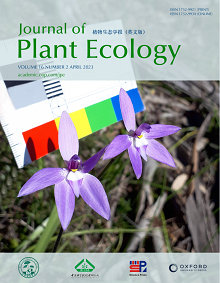Current Issue
-
 Volume 16 Issue 2
Volume 16 Issue 2
Two orchid individuals of wax-lip orchid or Glossodia major R.Br. The species is endemic to eastern Australia. It has a single purple flower per individual, and it displays dummy anthers, being a generalist in its pollination strategy. The photo was taken in the Mount Lofty Ranges, in South Australia, where wax-lip orchids are frequent and locally abundant, being representative of orchid communities in the region. The photographic scale card used to record orchid individuals was developed for the citizen science project Wild Orchid Watch (WOW). Photo taken by Samantha L. Bywaters. See Martín-Forés et al. in this issue.
IF: 3.9
CiteScore: 5.7
CiteScore: 5.7
Editors-in-Chief
Yuanhe Yang
Bernhard Schmid
Yuanhe Yang
Bernhard Schmid
CN 10-1172/Q
ISSN 1752-9921(print)
ISSN 1752-993X(online)
ISSN 1752-9921(print)
ISSN 1752-993X(online)







